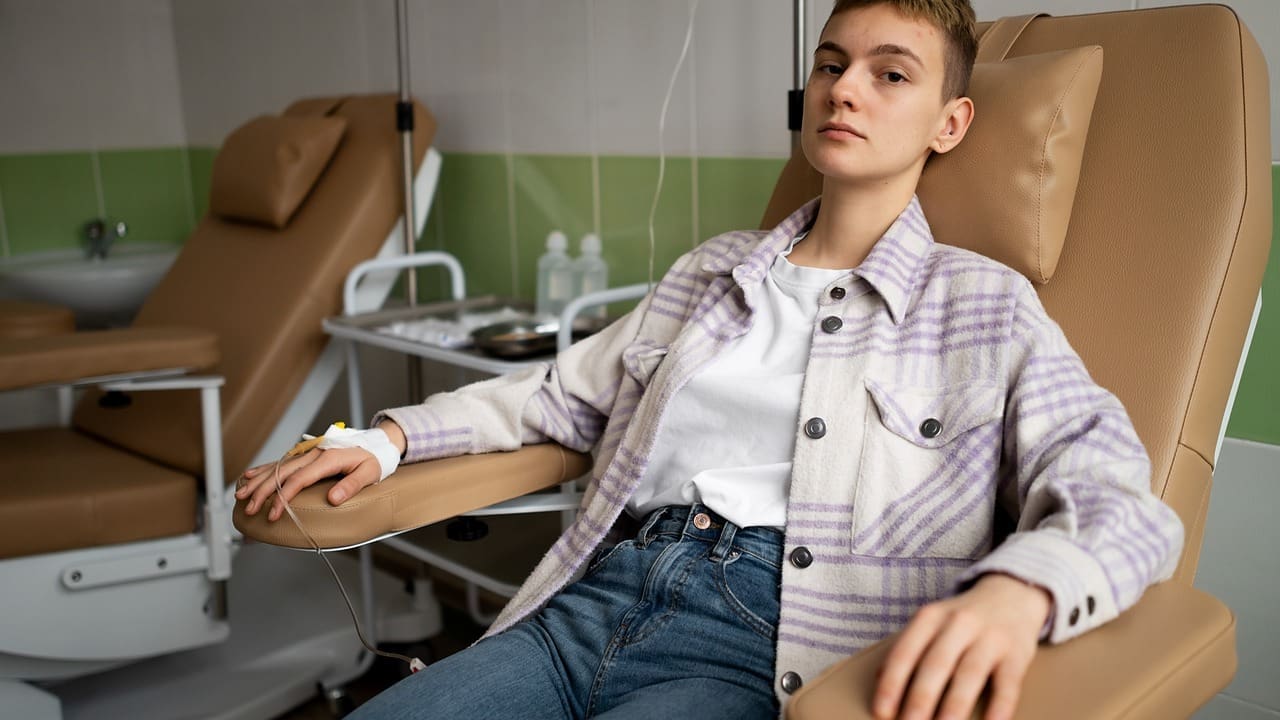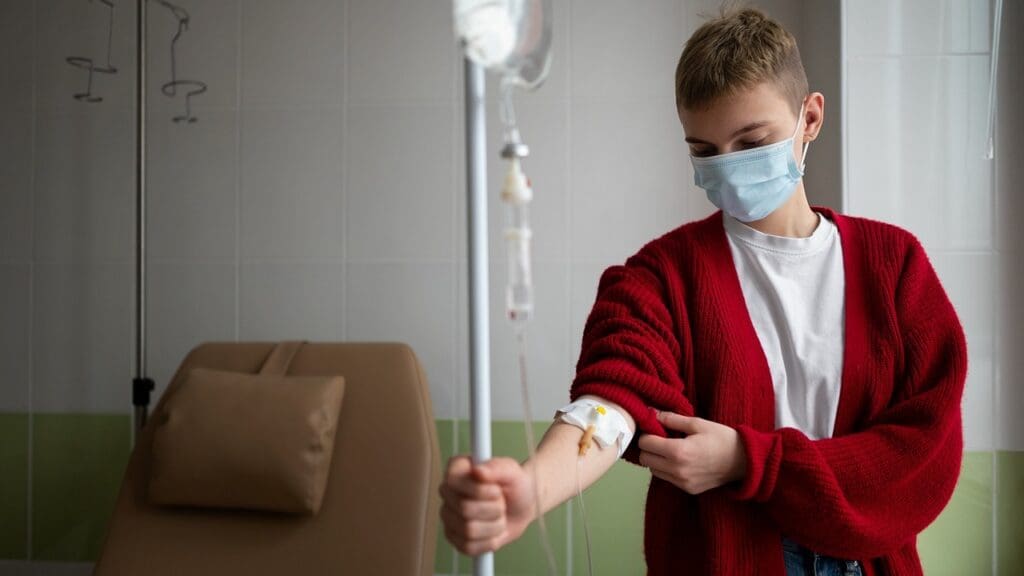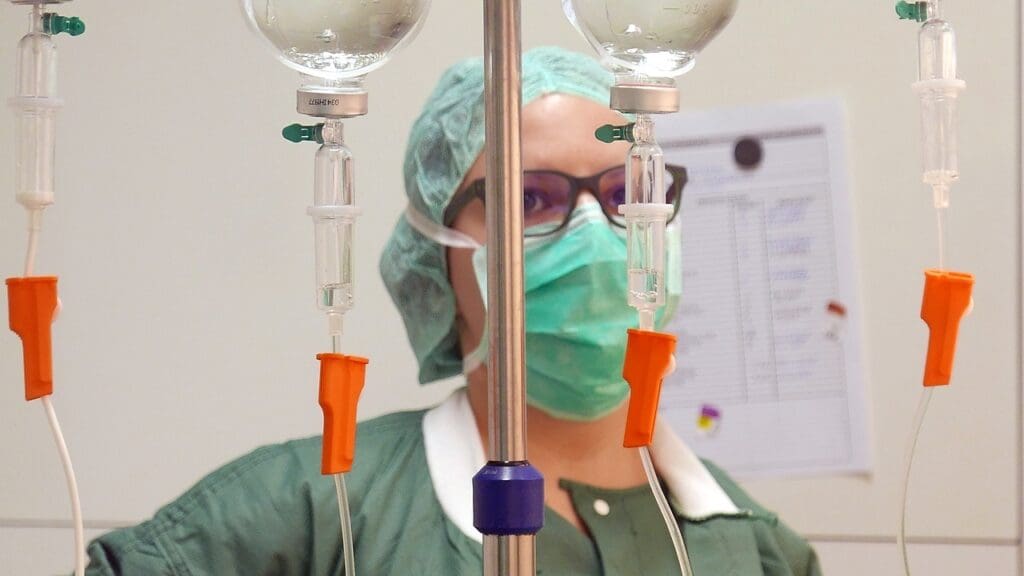Last Updated on November 26, 2025 by Bilal Hasdemir

Diagnosed with stage 4 diffuse large B-cell lymphoma, a condition where cancer has aggressively spread beyond the lymphatic system? At Liv Hospital, we understand the challenges you face and are committed to providing expert care and the latest treatment options.
Stage IV DLBCL represents the most advanced stage of this non-Hodgkin lymphoma subtype, requiring immediate and effective management. Fortunately, with treatment regimens like R-CHOP, patients can experience significant benefits, with median five-year survival rates reaching up to 55%. Our team stays updated with global standards, including advanced diagnostic tools from renowned institutions like Roche Diagnostics, to empower patients with hope and clarity.
We recognize the importance of personalized care in managing stage iv dlbcl. Our patient-focused approach ensures that each individual receives tailored treatment plans, addressing their unique needs and circumstances.
Key Takeaways
- Stage IV DLBCL is an aggressive form of non-Hodgkin lymphoma that requires immediate attention.
- Effective management involves advanced treatment regimens like R-CHOP.
- Median five-year survival rates can reach up to 55% with appropriate treatment.
- Personalized care is key for managing the disease effectively.
- Staying updated with global standards and diagnostic tools is essential for providing expert care.
Understanding Diffuse Large B-Cell Lymphoma (DLBCL)
Diffuse Large B-Cell Lymphoma (DLBCL) is a serious and aggressive type of non-Hodgkin lymphoma. It needs quick and effective treatment. DLBCL is the most common type of non-Hodgkin lymphoma, making up about 30% of all lymphoma cases worldwide.
What is DLBCL?
DLBCL is marked by large B cells spread out in the lymphoid tissue. It can start in lymph nodes or in other places like the gut, bones, or skin. The disease grows fast, causing symptoms to appear quickly, often in weeks or months.
People with DLBCL might have swollen lymph nodes, B symptoms like fever, night sweats, and weight loss, and feel very tired. In some cases, DLBCL can cause big, painful masses to grow quickly.
“The diagnosis of DLBCL is based on a combination of clinical findings, imaging studies, and histopathological examination of biopsy specimens.”
The Lymphoma Classification System
The World Health Organization (WHO) classifies lymphomas based on their look, immune markers, and genetics. DLBCL is a type of mature B-cell neoplasm. To diagnose it, doctors look for specific markers and check for other lymphoma types.
How DLBCL Differs from Other Lymphomas
DLBCL is different from other lymphomas because it grows fast and has unique features. Unlike slow-growing lymphomas, DLBCL needs treatment right away. It can be told apart from other aggressive lymphomas by its immune markers and genetics.
New treatments for DLBCL have made it easier for patients to fight the disease. The FDA has approved ZYNLONTA (loncastuximab tesirine-lpyl) for relapsed or refractory DLBCL. These advances show the ongoing work to find better treatments for this tough disease.
Stage IV DLBCL: Definition and Characteristics
Stage IV DLBCL is the most advanced stage of diffuse large B-cell lymphoma. It means the disease has spread far beyond the lymph nodes. This makes it very hard to treat.
How Stage IV DLBCL Is Defined
Stage IV DLBCL is when the lymphoma spreads to places outside the lymph nodes. This can include the liver, bone marrow, or lungs. Knowing this is important because it helps doctors decide how to treat the disease.
Key characteristics of Stage IV DLBCL include:
- Extranodal involvement: The disease has spread to organs outside the lymphatic system.
- Widespread lymph node involvement: Multiple lymph node groups are affected.
- Systemic symptoms: Patients may experience B symptoms such as fever, night sweats, and weight loss.
Extranodal Involvement in Advanced Disease
Extranodal involvement is a key feature of Stage IV DLBCL. The lymphoma can spread to organs like the liver, lungs, or bone marrow. This can cause different symptoms depending on the organ affected.
“The presence of extranodal disease at multiple sites complicates the treatment plan and often requires a more aggressive therapeutic approach.”
Common Organs Affected in Stage IV
In Stage IV DLBCL, several organs can be affected, including:
| Organ | Symptoms or Implications |
|---|---|
| Liver | Jaundice, abnormal liver function tests |
| Bone Marrow | Cytopenias, fatigue, increased risk of infections |
| Lungs | Respiratory symptoms, cough, shortness of breath |
Understanding how far the disease has spread is key to finding the right treatment. New treatments like CAR T-cell therapy and targeted therapies are being tested to help patients with advanced DLBCL.
As research keeps improving, we see new hope for treating Stage IV DLBCL. For example, Gilead Sciences is working on a new drug called Trodelvy. It’s a treatment for various cancers, including DLBCL.
Recognizing Symptoms of Stage IV DLBCL
It’s important to know the symptoms of Stage IV Diffuse Large B-Cell Lymphoma (DLBCL) for quick medical help. Spotting the signs and symptoms is key for managing the disease well.
B Symptoms: Fever, Night Sweats, and Weight Loss
Stage IV DLBCL often brings systemic symptoms, known as B symptoms. These include fever, night sweats, and weight loss. These signs are not just uncomfortable but also show how the body is fighting the lymphoma.
Fever can keep coming back and doesn’t always go away with usual treatments. Night sweats can be very bad, messing with sleep and health. Unexplained weight loss happens quickly and is a big warning sign.
These symptoms can really hurt a person’s quality of life. Tests from companies like Roche help find and manage DLBCL. They help understand how far the disease has spread.
Organ-Specific Symptoms
Patients with Stage IV DLBCL may also have symptoms related to specific organs. For example, if the lymphoma affects the stomach, it can cause pain, changes in bowel movements, or bleeding. If it touches the brain, it can lead to headaches, confusion, or seizures.
It’s important to know these symptoms can be different for everyone. Being aware of them helps catch the disease early and treat it better.
When to Seek Medical Attention
If you or someone you know has symptoms of Stage IV DLBCL, get medical help right away. Catching it early can make a big difference in treatment success. We urge everyone to watch their health closely and see a doctor if they notice anything strange or lasts too long.
By knowing and spotting the symptoms of Stage IV DLBCL, we can get to diagnosis and treatment faster. This helps manage the disease better.
Diagnosis and Staging Process
Diagnosing and staging DLBCL are key steps in finding the best treatment for patients, like those with Stage IV. Accurate staging is vital for choosing the right treatment. This is because Stage III and Stage IV DLBCL might need different treatments.
Initial Evaluation and Physical Examination
The first step is a detailed medical history and physical check-up. We look for signs like swollen lymph nodes, fever, night sweats, or weight loss. We also check the patient’s overall health and any past treatments or conditions.
Physical examination findings help us understand how far the disease has spread. For example, swollen lymph nodes or tumors in other parts of the body guide further tests.
Imaging Studies for Advanced Disease
Imaging tests are essential for diagnosing and staging DLBCL. We use CT scans, PET scans, and MRI to see how far the disease has spread. These tests show the size and location of tumors and if they have spread.
Advanced imaging techniques like PET-CT scans are great for checking how active tumors are and how well they respond to treatment.
Biopsy and Laboratory Tests
A biopsy is needed to confirm DLBCL. We take a sample of the affected lymph node or tissue. Tests like histopathology, immunophenotyping, and molecular diagnostics are done on this sample to confirm the diagnosis and type of lymphoma.
We also do blood tests to check the patient’s health, look for any abnormalities related to lymphoma, and watch for treatment side effects.
New treatments, like ADC Therapeutics’ clinical trials for ZYNLONTA in DLBCL, show how important accurate diagnosis and staging are. They help find patients who can benefit from new therapies.
Standard Treatment Approaches for Stage IV DLBCL
We will explore the standard treatment options for Stage IV DLBCL. We’ll look at how well they work and when to use them. Treating Stage IV Diffuse Large B-Cell Lymphoma requires a mix of therapies. The goal is to get the cancer into remission and improve survival chances.
R-CHOP Chemotherapy Regimen
The R-CHOP regimen is key in treating Stage IV DLBCL. It includes Rituximab, Cyclophosphamide, Doxorubicin, Vincristine, and Prednisone. This combo has greatly improved outcomes for those with advanced DLBCL.
Treatment Outcomes with R-CHOP: Research shows that R-CHOP can lead to a 55% five-year survival rate for Stage IV DLBCL patients.
| Treatment Component | Function |
|---|---|
| Rituximab | Targets CD20-positive B cells |
| Cyclophosphamide | Damages DNA to prevent cancer cell replication |
| Doxorubicin | Intercalates DNA strands, inhibiting cancer cell growth |
| Vincristine | Disrupts microtubule formation, halting cell division |
| Prednisone | Reduces inflammation and kills lymphoma cells |
Radiation Therapy in Advanced DLBCL
Chemotherapy is the main treatment for Stage IV DLBCL. But, radiation therapy might be used in some cases. This could be for localized disease or to ease symptoms.
Role of Radiation Therapy: Radiation helps control symptoms and shrink tumors. It improves the quality of life for patients.
Stem Cell Transplantation Options
Stem cell transplantation is considered for some patients. This is often for those with refractory or recurrent disease. The procedure replaces damaged stem cells with healthy ones.
Types of Stem Cell Transplantation:
- Autologous stem cell transplantation (using the patient’s own stem cells)
- Allogeneic stem cell transplantation (using donor stem cells)
New treatments like CAR T-cell therapy and targeted therapies are being studied. For example, Gilead’s Trodelvy is in Phase 3 trials for DLBCL and other cancers.
Innovative and Emerging Treatments
New treatments are being developed for Stage IV DLBCL. These treatments offer hope for better outcomes and quality of life for patients.
CAR T-Cell Therapy
CAR T-cell therapy is a new approach. It modifies T-cells to attack cancer cells. This therapy shows promise in treating DLBCL that doesn’t respond to other treatments.
Early results from trials are promising. But, it can cause side effects like cytokine release syndrome. Managing these side effects is key.
Novel Targeted Therapies
Targeted therapies aim to hit cancer cells hard but spare healthy ones. ADC Therapeutics is working on new antibody-drug conjugates for DLBCL.
These therapies are designed to be more precise and less toxic than traditional chemotherapy. They target specific proteins on lymphoma cells, delivering a toxic payload directly to them.
Immunotherapy Approaches
Immunotherapy is another promising area. It uses the immune system to fight cancer. This approach holds great hope for treating Stage IV DLBCL.
Current Clinical Trials for Stage IV DLBCL
Many clinical trials are exploring new treatments for Stage IV DLBCL. These trials are vital for understanding the safety and effectiveness of these new therapies.
Some trials are looking at combining new agents with existing treatments. This aims to make treatments more effective.
| Therapy Type | Description | Potential Benefits |
|---|---|---|
| CAR T-Cell Therapy | Modified T-cells to target cancer cells | High response rates in relapsed/refractory DLBCL |
| Novel Targeted Therapies | Targeted drugs to specific cancer cell proteins | Precision treatment with potentially fewer side effects |
| Immunotherapy | Harnessing the immune system to fight cancer | Potential for durable responses and improved survival |
We are committed to keeping up with these new developments. We want to make sure our patients have access to the best treatments for Stage IV DLBCL.
Managing Refractory or Recurrent Disease
Refractory or recurrent DLBCL is a big challenge. It needs new and effective plans. Patients who don’t respond to first treatment or have it come back need special care.
Second-Line Treatment Options
For those with refractory or recurrent DLBCL, second-line treatments are key. These can be different chemo, targeted therapies, or clinical trials. We focus on personalized plans based on health, past treatments, and disease details.
Choosing the right second-line treatment is important. It could mean getting stem cell transplants. Our team helps pick the best path for each patient, ensuring they get the right care.
Salvage Therapy Approaches
Salvage therapy is vital for managing refractory or recurrent DLBCL. It uses strong chemo and sometimes stem cell transplants. We use advanced tools, like Roche’s diagnostic solutions, to track how well treatments work and find any remaining disease.
Patients on salvage therapy need careful watching and support. Our team offers full support during treatment, helping manage side effects and complications.
Long-term Monitoring and Surveillance
Long-term watching and checking are key for managing refractory or recurrent DLBCL. Regular check-ups and scans help catch any disease coming back early. We help create a follow-up plan that meets each patient’s needs for the best results.
In summary, managing refractory or recurrent DLBCL needs a detailed and personal approach. Using new treatments, like second-line and salvage therapies, and keeping a close eye on patients can lead to better outcomes and quality of life.
Comparing Stage IV DLBCL with Earlier Stages
Looking at Stage IV DLBCL and earlier stages shows big differences in treatment and how well patients do. We’ll see how Stage 2 and Stage 3 DLBCL are different from Stage IV. This includes how the disease acts, treatment options, and how well patients do.
Stage 2 B-Cell Lymphoma Characteristics
Stage 2 B-cell lymphoma is less severe than Stage IV. It affects lymph nodes in two or more areas on the same side of the diaphragm. Patients at this stage usually have a disease that’s more contained, leading to a better outlook than Stage IV. The disease mainly stays in the lymph nodes, making it easier to treat.
- Lymph node involvement in multiple regions
- Disease limited to one side of the diaphragm
- Potential for more effective treatment due to localized disease
Stage 3 Large B-Cell Lymphoma Progression
Stage 3 large B-cell lymphoma is more advanced than Stage 2. It affects lymph nodes on both sides of the diaphragm. This stage means the disease is more spread out than Stage 2 but not as much as Stage IV. Moving to Stage 3 makes treatment more complicated.
- Lymph node involvement on both sides of the diaphragm
- Increased disease spread compared to Stage 2
- More complex treatment requirements
Treatment and Prognosis Differences by Stage
The stage of DLBCL diagnosis greatly affects treatment and how well patients do. Stage IV DLBCL needs more aggressive and complex treatments because it’s so widespread. Earlier stages might get less intense treatments.
Survival Rate Comparisons
Survival rates for DLBCL vary a lot by stage. Generally, earlier stages have better survival rates than advanced stages like Stage IV. Studies show that Stage II DLBCL has a much higher 5-year survival rate than Stage IV.
| Stage | 5-Year Survival Rate |
|---|---|
| Stage II | Higher survival rate |
| Stage III | Moderate survival rate |
| Stage IV | Lower survival rate |
New treatments, like Gilead’s Trodelvy, are helping with B-cell malignancies, including DLBCL. These new options are improving patient outcomes across different stages.
Conclusion: Living with Stage IV DLBCL
Living with stage 4 diffuse large b cell lymphoma can be tough. But, with the right care and support, patients can handle it. At ADC Therapeutics, we aim to better the lives of DLBCL patients with new therapies and support.
Managing stage IV DLBCL needs a team effort. Knowing about the disease and treatment options helps patients make smart choices. This includes looking into new therapies and support to ease symptoms and enhance life quality.
For those with stage 4 dlbcl, teaming up with healthcare providers is key. Even though stage 3 has its own treatment paths, the focus on care is the same. By giving top-notch healthcare and support, we help patients face DLBCL’s challenges and improve their chances.
FAQ
What is Stage IV DLBCL, and how is it different from earlier stages?
Stage IV DLBCL is a serious stage of Diffuse Large B-Cell Lymphoma. It means the cancer has spread to other parts of the body like the liver, bone marrow, or lungs. This is different from earlier stages because it has spread further and to more areas.
What are the common symptoms of Stage IV DLBCL?
Symptoms include fever, night sweats, and weight loss. You might also feel tired, have swollen lymph nodes, and experience pain or other symptoms depending on where the cancer is.
How is Stage IV DLBCL diagnosed and staged?
Doctors use a physical exam, imaging like CT or PET scans, and a biopsy to diagnose. They also do lab tests to see how far the disease has spread and what stage it is.
What are the standard treatment approaches for Stage IV DLBCL?
Treatments include R-CHOP chemotherapy and sometimes radiation therapy or stem cell transplantation. This combination aims to fight the cancer effectively.
Are there any innovative treatments available for Stage IV DLBCL?
Yes, new treatments like CAR T-cell therapy and targeted therapies are being tested. They offer hope for better outcomes in advanced DLBCL.
How does the prognosis for Stage IV DLBCL compare to earlier stages?
Stage IV DLBCL has a less favorable outlook than earlier stages. But, with modern treatments, many patients can see their disease controlled or go into remission.
What is the role of stem cell transplantation in treating Stage IV DLBCL?
Stem cell transplantation is considered for some patients with Stage IV DLBCL. It’s often for those who respond well to initial treatments or have relapsed disease.
How is refractory or recurrent DLBCL managed?
For refractory or recurrent DLBCL, doctors use second-line treatments and salvage therapies. They also keep a close eye on the patient to catch any signs of disease coming back.
What is the significance of B symptoms in Stage IV DLBCL?
B symptoms indicate a more aggressive disease and can affect the prognosis. They are used in staging and assessing the disease’s overall burden.
Can Stage IV DLBCL be cured?
While “cure” is a complex term in cancer, some patients with Stage IV DLBCL can achieve long-term remission. Ongoing research aims to improve these outcomes.
What is the difference between Stage 3 and Stage 4 DLBCL?
Stage 3 DLBCL affects lymph nodes on both sides of the diaphragm. Stage 4 means the disease has spread to organs or tissues outside the lymphatic system.
How does the treatment for Stage 3 DLBCL differ from Stage 4?
The basic treatment is similar, but the intensity and specific treatments can vary. Stage 4 might need more aggressive or additional treatments.
What is Stage IV DLBCL, and how is it different from earlier stages?
Stage IV DLBCL is a serious stage of Diffuse Large B-Cell Lymphoma. It means the cancer has spread to other parts of the body like the liver, bone marrow, or lungs. This is different from earlier stages because it has spread further and to more areas.
What are the common symptoms of Stage IV DLBCL?
Symptoms include fever, night sweats, and weight loss. You might also feel tired, have swollen lymph nodes, and experience pain or other symptoms depending on where the cancer is.
How is Stage IV DLBCL diagnosed and staged?
Doctors use a physical exam, imaging like CT or PET scans, and a biopsy to diagnose. They also do lab tests to see how far the disease has spread and what stage it is.
What are the standard treatment approaches for Stage IV DLBCL?
Treatments include R-CHOP chemotherapy and sometimes radiation therapy or stem cell transplantation. This combination aims to fight the cancer effectively.
Are there any innovative treatments available for Stage IV DLBCL?
Yes, new treatments like CAR T-cell therapy and targeted therapies are being tested. They offer hope for better outcomes in advanced DLBCL.
How does the prognosis for Stage IV DLBCL compare to earlier stages?
Stage IV DLBCL has a less favorable outlook than earlier stages. But, with modern treatments, many patients can see their disease controlled or go into remission.
What is the role of stem cell transplantation in treating Stage IV DLBCL?
Stem cell transplantation is considered for some patients with Stage IV DLBCL. It’s often for those who respond well to initial treatments or have relapsed disease.
How is refractory or recurrent DLBCL managed?
For refractory or recurrent DLBCL, doctors use second-line treatments and salvage therapies. They also keep a close eye on the patient to catch any signs of disease coming back.
What is the significance of B symptoms in Stage IV DLBCL?
B symptoms indicate a more aggressive disease and can affect the prognosis. They are used in staging and assessing the disease’s overall burden.
Can Stage IV DLBCL be cured?
While “cure” is a complex term in cancer, some patients with Stage IV DLBCL can achieve long-term remission. Ongoing research aims to improve these outcomes.
What is the difference between Stage 3 and Stage 4 DLBCL?
Stage 3 DLBCL affects lymph nodes on both sides of the diaphragm. Stage 4 means the disease has spread to organs or tissues outside the lymphatic system.
How does the treatment for Stage 3 DLBCL differ from Stage 4?
The basic treatment is similar, but the intensity and specific treatments can vary. Stage 4 might need more aggressive or additional treatments.








